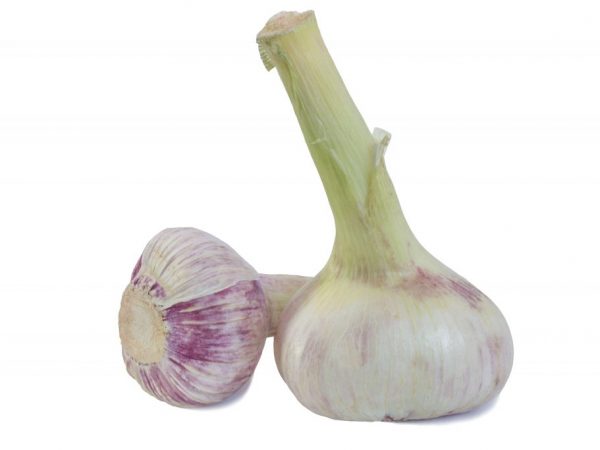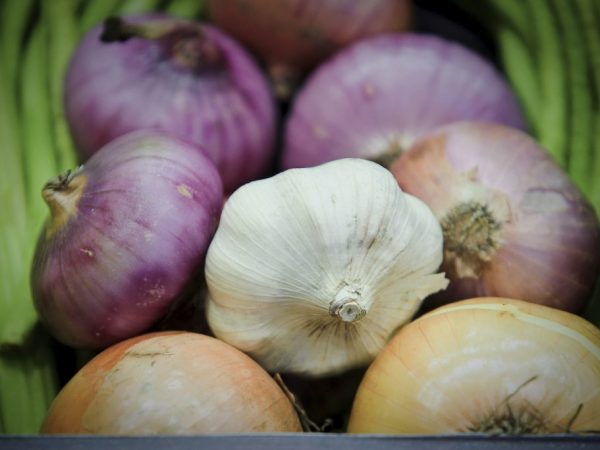How to grow large garlic in the garden
All gardeners and summer residents grow garlic in their beds, because it is known for its healing properties, and is also used in the preparation of many dishes. Harvesting this herbaceous plant won't be a hassle. Anyone who is engaged in gardening, without any fertilizers, will be able to collect garlic with small heads. But not every gardener knows how to grow large garlic.

Large garlic
All that is required to obtain large garlic is adherence to the cultivation technology and the correct approach to the choice of planting material. These simple rules will help you get the largest and highest quality harvest in comparison with other summer residents.
How to choose garlic
The future yield and quality of the crop depend half on the correctly selected material for planting. The main indicators of the superior quality of the product are its hardness and dryness. Here are some secrets to help you when choosing planting bulbs:
- Garlic bulbs with large heads are the best option. They must be undamaged and undamaged. Ideally, the teeth should be the same size.
- It is not recommended to plant heads with 3-4 teeth, as this is a sign of the degeneration of the variety. It is better to use heads with 5 or more teeth.
- If you plan to plant garlic before winter, then you should choose purple-striped varieties, as they are more resistant to winter temperatures and less whimsical to growing conditions.
- It is better to buy local, regionalized seed, because it is already adapted to local climatic conditions.
- Do not buy bulbs with burnt bottoms. It is also important that there are no cracks on the bottom, as this is a sign of infection.
- Small garlic will not produce a large crop. But young greens can be grown from small teeth.
It is necessary to approach the issue of the choice of planting material with all responsibility. With these tricks, you will be able to find the right garlic bulbs that will give you a good harvest. The main thing to remember is the rule: we plant large cloves - we get a large head of garlic.
Varieties of garlic
There are 2 types of garlic, which differ in terms of planting and the size of the heads: spring and winter. The spring species (another name for summer) is planted in the spring, and the winter (another name for the winter) - in the fall. Spring garlic grows in a non-arrow-shaped form, and winter garlic can also grow in an arrow-shaped form.
Experienced gardeners plant both species because winter varieties develop earlier. And after harvesting them, you can expect the appearance of an ardent variety. It is important not to confuse the planting dates, since then the plant will not grow. Spring garlic will yield a harvest only during spring planting in the garden, winter garlic can bring large and healthy heads, but only when planting in autumn.If you plant its teeth in the spring, then it will also be able to form, but the crop will be of poor quality and unable to be stored for a long time.
Differences
Outwardly, these cultures are similar, but their structure is slightly different. Winter garlic has a stem in the center of the head, on which teeth usually grow in even numbers. When they are separated, the stem remains naked. And in the spring - there is no rod, the number of teeth can vary. They are more curved in shape because they fit snugly together. The largest teeth are on the outside, and the smallest ones are in the middle.
The yield of the winter species is much higher. In addition, winter garlic is larger than spring garlic. But the disadvantage is that it is poorly stored. By the middle of winter, its teeth begin to dry out and need special care in order to be suitable for future sowing. Experts recommend planting arrowhead varieties.
The advantage of spring varieties is that they can be stored for almost 2 years without changing their shape and qualities. Therefore, when you decide which garlic to plant, you need to consider for what purpose you are doing it: to sell or for personal needs. For sale, it is better to grow a winter variety because of its high yield. For personal purposes, it is recommended to use spring, because it will last all winter and is very large in size.
Spring garlic planting rules

Observing the rules, a good harvest grows
To grow summer garlic healthy and large, you must adhere to planting dates and growing technology.
Landing dates
The growing season of this variety is much shorter, so it should be planted very early. The most suitable time for landing in the ground is the first half of April. The garlic bulb will have time to form properly.
It is very important that the air temperature is not higher than 10 ° C, since the roots stop growing at high temperatures. The optimal temperature regime for the root system is from 5 to 10 ° C. Healthy roots are the key to large heads. If you plant the cloves later, then the yield will be much lower.
Growing technology
You should know a few simple rules to grow large garlic:
- Water the plant abundantly until mid-July, during the growth of greenery. If the tips of the stem turn yellow, then the plant does not have enough water. But if you water it very often and a lot, then the bulb will be poorly formed and will be poorly stored, in addition, there will be much less nutrients.
- The soil should be loosened after each watering to ensure that oxygen enters the soil.
- In the first half of August, you need to tie all the leaves of the plant together so that they absorb less minerals necessary for the growth of the garlic bulb.
- In order for the garlic to be large and stored for a long time, it is recommended to systematically feed the plant. This process must be combined with watering.
Crop rotation is of great importance. Avoid planting spring varieties after crops such as potatoes, tomatoes, and onions. You need to choose a place for sowing sunny and one where water does not stagnate. Since autumn, the soil is fertilized with compost, humus and a small amount of ash. Before planting, the soil should be loosened.
In order for the plant to develop well and receive the necessary nutrients, attention must be paid to the density of planting. The distance between the beds should be about 30 cm. Each clove should be placed in the ground at a distance of 7 cm from each other. Do not deepen the slices too deep into the ground, this will slow down their development. After planting, you can cover the ground with straw or peat.
Rules for planting winter garlic
In order for winter varieties of garlic to grow with large and high-quality heads, you need to know the features of this type and the basic rules for growing and caring for the crop.
Landing dates
It is necessary to plant the cloves in the ground before the onset of frost, namely 40 days before the first significant drop in temperature.It could be early or mid-October. Make sure that the air temperature at night is about 10 ° C. At this temperature, the root system will have time to form, not letting the green shoots out.
You should not grow garlic in the same place for more than 2 years in a row, but it is better to change the place every year. It is necessary to take into account the predecessors, suitable crops are tomato, pepper, cucumber, cabbage and some others. It is allowed to plant garlic next to fruit bushes.
Growing technology
To keep the garlic heads healthy, you need to disinfect the soil. Experts recommend sowing phacelia, which protects the soil from the appearance of fungi, destroys pests and is a good deoxidizer. You can fertilize the soil with high-moor peat, sand, sawdust of deciduous trees. For the autumn digging of the earth, complex fertilizers are used. And a couple of days before the planting itself, ammonium nitrate or root solution is added to the soil.
The plant needs abundant watering, especially during the formation of cloves. The soil should be moist up to 30 cm deep. The first time you need to water the land in early May, the next watering should be done with a frequency of at least 5-10 days. It is necessary to feed and loosen the soil in a timely manner: the first time on frozen ground, the second time in a month and the third - when a garlic bulb is the size of a walnut.
Conclusion
It is quite simple to grow large heads, for this it is enough to know the cultivation technology and biological characteristics of the varieties of such a vegetable. It is necessary to adhere to the timing of planting cloves, follow the rules of loosening, watering and fertilizing the soil, and also protect the crop from diseases and pests.


